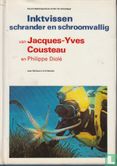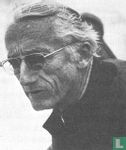Glossy paper, (many) color photos
Jacques-Yves Cousteau (Saint-André-de-Cubzac, June 11, 1910 - Paris, June 25, 1997) was a French naval officer, explorer and researcher who studied the sea and all its life forms. In France he was known as le commandant Cousteau ("Commander Cousteau"), outside France as Jacques Cousteau or Captain Cousteau. He has been honored with French honors such as Commandeur de l'ordre national de la Légion d'honneur and and the Grand-Croix of the l'ordre national du Mérite.
Biography:
Years before 1940:
He was admitted to the École Navale (maritime academy) in Brest and became an officer in the French navy, which gave him the opportunity to conduct underwater experiments. In 1936 he tested underwater goggles, possibly the ancestor of modern diving masks. Cousteau married Simone Melchior in 1937. They had two sons, Jean-Michel Cousteau (1938) and Philippe Cousteau (1940 - 1979), who were later also involved in the Calypso expeditions.
WWII:
In the Second World War he was critical of the occupiers. In his book Le Monde du Silence he tells that in 1942 the German occupiers in the naval base of Toulon left him and his employees undisturbed in his work. Apparently they were impressed by his ordre de mission: the assignment of the International Committee for the Exploration of the Mediterranean Sea, during this period he developed diving equipment in secret together with Emile Gagnan (ready in 1943). This "aqua-lung" consisted of a regulator that delivered high pressure air from a diving cylinder at the correct (i.e. ambient) pressure, depending on the diver's requirement, via a pressure reducing valve and demand valve. Before that, experiments had only been done with systems where a constant amount of air was delivered, or closed systems where the exhaled oxygen was re-inhaled (see rebreather). This aqua-lung was used in secret in Six-Fours Bay. les-Plages, a French seaside resort on the Mediterranean. Near this place hangs a copper plaque that was hung there after the war.
In the years after the war, he developed techniques for clearing sea mines in French ports and explored shipwrecks. He also formed a special research group (Groupe de Recherches Sous-Marines) in Toulon with Frédéric Dumas and a few other naval officers.
Expedition ships:
His first expedition ship after the Second World War was the l'Elie Monnier, with which he traveled the Mediterranean with his friends Philippe Tailliez and Frédéric Dumas from 1948. These early expedition stories are recorded in the book Le Monde du Silence. This ship was also the basis of the first activities of the Groupe de Recherches Sous-Marines. In 1950 he bought his famous ship, the Calypso, with which he made many films and books about the underwater world. One of his films won the main prize at the Cannes Film Festival in 1956. These works contributed greatly to the popularity of underwater biology.
Projects:
Another important initiative of Cousteau was the construction of underwater enclosures or 'habitats', the so-called Conshelf (Continental Shelf) projects. Conshelf one was stationed in 1962 in the Mediterranean near Marseilles, Conshelf two in 1963, in the Red Sea off the coast of Sudan, and Conshelf three in 1965 in the Mediterranean near the île du Levant. Conshelf two has also been made into a film in the award-winning documentary Le Monde sans Soleil. Later Cousteau was also involved in the construction of an experimental wind turbine powered sailing vessel, the Alcyone. Cousteau developed in 1963 together with Jean de Wouters an underwater camera called "Calypso-Phot", later licensed to Nikon and thus became the "Nikonos".
Together with Jean Mollard, he developed the "SP-350", a two-person submarine that reached a depth of 350 meters below the water surface. In 1965 the experiment was repeated and two vehicles reached a depth of 500 meters.
Later career and initiatives:
Cousteau was appointed director of the Oceanographic Museum of Monaco, was the leader of the working group for saturation diving (long stay on the seabed, the first manned underwater colonies) and is one of the few foreigners admitted to the American Academy of Sciences. Cousteau developed into an active environmental activist during this time. He is known, among other things, for his support for a massive protest in 1960 in France against the dumping of radioactive waste in the sea. A large group of adults and children then managed to stop the train with waste and let it return.
In 1974 he founded the Cousteau Society for the Protection of Ocean Life and was awarded the United Nations International Environmental Award in 1977 with Peter Scott and a few years later the American Liberty Medal from Jimmy Carter, then President of the United States. States of America.
Years after 1990:
December 1, 1990: his first wife Simone dies of cancer.
June 1991: Cousteau marries Francine Triplet. They already had a daughter Diane Cousteau (1980) and a son Pierre-Yves Cousteau (1982) from the period before their marriage.
1992: Invitation to the UN Environmental Conference in Rio de Janeiro (Brazil). Cousteau becomes an advisor to the UN and the World Bank.
June 25, 1997: Cousteau dies.
Topical:
The many films that Cousteau made about his expeditions to all corners of the world are still regularly broadcast on television and keep the memory of him and the Calypso alive.
This text has been translated automatically from Dutch
Click here for the original text
Glanspapier, (veel) foto's kleur
Jacques-Yves Cousteau (Saint-André-de-Cubzac, 11 juni 1910 – Parijs, 25 juni 1997) was een Frans marineofficier, ontdekkingsreiziger en onderzoeker, die de zee bestudeerde en alle daarin voorkomende levensvormen. In Frankrijk was hij bekend onder de naam le commandant Cousteau ("Commander Cousteau"), buiten Frankrijk als Jacques Cousteau of kapitein Cousteau. Hij is onderscheiden met Franse onderscheidingen als Commandeur de l'ordre national de la Légion d'honneur en en het Grand-Croix van de l'ordre national du Mérite.
Biografie:
Jaren voor 1940:
Hij werd toegelaten op de École Navale (maritieme academie) in Brest en werd officier van de Franse marine, die hem de mogelijkheid gaf met onderwaterexperimenten bezig te zijn. In 1936 testte hij een onderwaterbril, mogelijk de voorouder van de moderne duikmaskers. Cousteau trouwde in 1937 met Simone Melchior. Zij kregen twee zoons, Jean-Michel Cousteau (1938) en Philippe Cousteau (1940 - 1979), die later ook betrokken waren in de Calypso expedities.
Tweede Wereldoorlog:
In de Tweede Wereldoorlog stond hij kritisch tegenover de bezetters. In zijn boek Le Monde du Silence vertelt hij dat de Duitse bezetters in de marinebasis Toulon hem en zijn medewerkers in 1942 ongemoeid lieten bij zijn werk. Kennelijk waren zij onder de indruk van zijn ordre de mission: de opdracht van het Internationale Comité tot Exploratie van de Middellandse zee, Hij ontwikkelde in deze periode samen met Emile Gagnan in het geheim duikapparatuur (gereed in 1943). Deze "aqua-lung" bestond uit ademautomaat dat afhankelijk van behoefte van de duiker via een drukreduceerventiel en vraagklep lucht van hoge druk uit een duikcilinder op de goede (d.w.z. omgevings-) druk leverde. Voor die tijd, waren eigenlijk alleen experimenten gedaan met systemen waarbij een constante hoeveelheid lucht werd geleverd, of gesloten systemen waarbij de uitgeademde zuurstof weer werd ingeademd (zie rebreather) Deze aqua-lung werd in het geheim gebruikt in de baai van Six-Fours-les-Plages, een Franse badplaats aan de Middellandse Zee. Nabij deze plek hangt een koperen plakkaat die daar na de oorlog werd opgehangen.
In de jaren na de oorlog ontwikkelde hij technieken voor het opruimen van zeemijnen in Franse havens en verkende hij scheepswrakken. Tevens vormde hij met Frédéric Dumas en enkele andere marineofficieren een speciale onderzoeksgroep (Groupe de Recherches Sous-Marines) in Toulon.
Expeditieschepen:
Zijn eerste expeditieschip na de tweede wereldoorlog was de l'Elie Monnier waarmee hij vanaf 1948 samen met zijn vrienden Philippe Tailliez en Frédéric Dumas de Middellandse zee bereisde. Deze vroege expeditieverhalen zijn vastgelegd in het boek Le Monde du Silence. Dit schip was ook de basis van de eerste activiteiten van de Groupe de Recherches Sous-Marines. In 1950 kocht hij zijn beroemde schip, de Calypso, waarmee hij menig film en boek over de onderwaterwereld maakte. Eén van zijn films won de belangrijkste prijs op het filmfestival van Cannes in 1956. Deze werken droegen veel bij aan de populariteit van de onderwaterbiologie.
Projecten:
Een ander belangrijk initiatief van Cousteau was de bouw van onderwaterverblijven of 'habitats', de zogenaamde Conshelf (Continental Shelf) projecten. Conshelf één was in 1962 gestationeerd in de Middellandse zee nabij Marseille, Conshelf twee in 1963, in de Rode Zee voor de kust van Soedan, en Conshelf drie in 1965 in de Middellandse zee nabij het île du Levant. Conshelf twee is ook verfilmd in de bekroonde documentaire Le Monde sans Soleil. Later was Cousteau ook betrokken bij bouw van een experimenteel door windturbines aangedreven zeilschip, de Alcyone. Cousteau ontwikkelde in 1963 samen met Jean de Wouters een onderwatercamera genaamd "Calypso-Phot", later gelicentieerd aan Nikon en werd zo de "Nikonos".
Samen met Jean Mollard ontwikkelde hij de "SP-350", een tweepersoonsduikboot die een diepte van 350 meter onder het wateroppervlak bereikte. In 1965 werd het experiment herhaald en bereikten twee voertuigen een diepte van 500 meter.
Latere carrière en initiatieven:
Cousteau werd benoemd tot directeur van het oceanografisch museum van Monaco, was de leider van de werkgroep voor saturatieduiken (langdurig verblijf op de zeebodem, de eerste bemande onderwaterkolonies) en is één van de weinige buitenlanders die toegelaten werd tot de Amerikaanse Academy of Sciences. Cousteau ontwikkelde zich in deze tijd tot een actieve milieuactivist. Bekend is o.a. zijn steun aan een massaal protest in 1960 in Frankrijk tegen storting van radioactief afval in zee. Een grote groep volwassenen en kinderen wisten toen de trein met afval tegen te houden, en terug te laten keren.
In 1974 richtte hij de Cousteau Society op voor de bescherming van het leven in de oceanen en kreeg in 1977 samen met Peter Scott de internationale milieuprijs van de VN en een paar jaar later de Amerikaanse Liberty Medal van Jimmy Carter, die toen president van de Verenigde Staten van Amerika was.
Jaren na 1990:
1 December 1990: zijn eerste vrouw Simone overlijdt aan kanker.
Juni 1991: Cousteau trouwt met Francine Triplet. Zij hadden reeds een dochter Diane Cousteau (1980) en een zoon Pierre-Yves Cousteau (1982) uit de periode voor hun huwelijk.
1992: uitnodiging voor de milieuconferentie in Rio de Janeiro (Brazilië) van de VN. Cousteau wordt adviseur voor de VN en de Wereldbank.
25 Juni 1997: Cousteau overlijdt.
Actueel:
De vele films die Cousteau maakte over zijn expedities naar alle uithoeken van de wereld worden nog steeds regelmatig uitgezonden op televisie en houden de herinnering aan hem en de Calypso levend.







